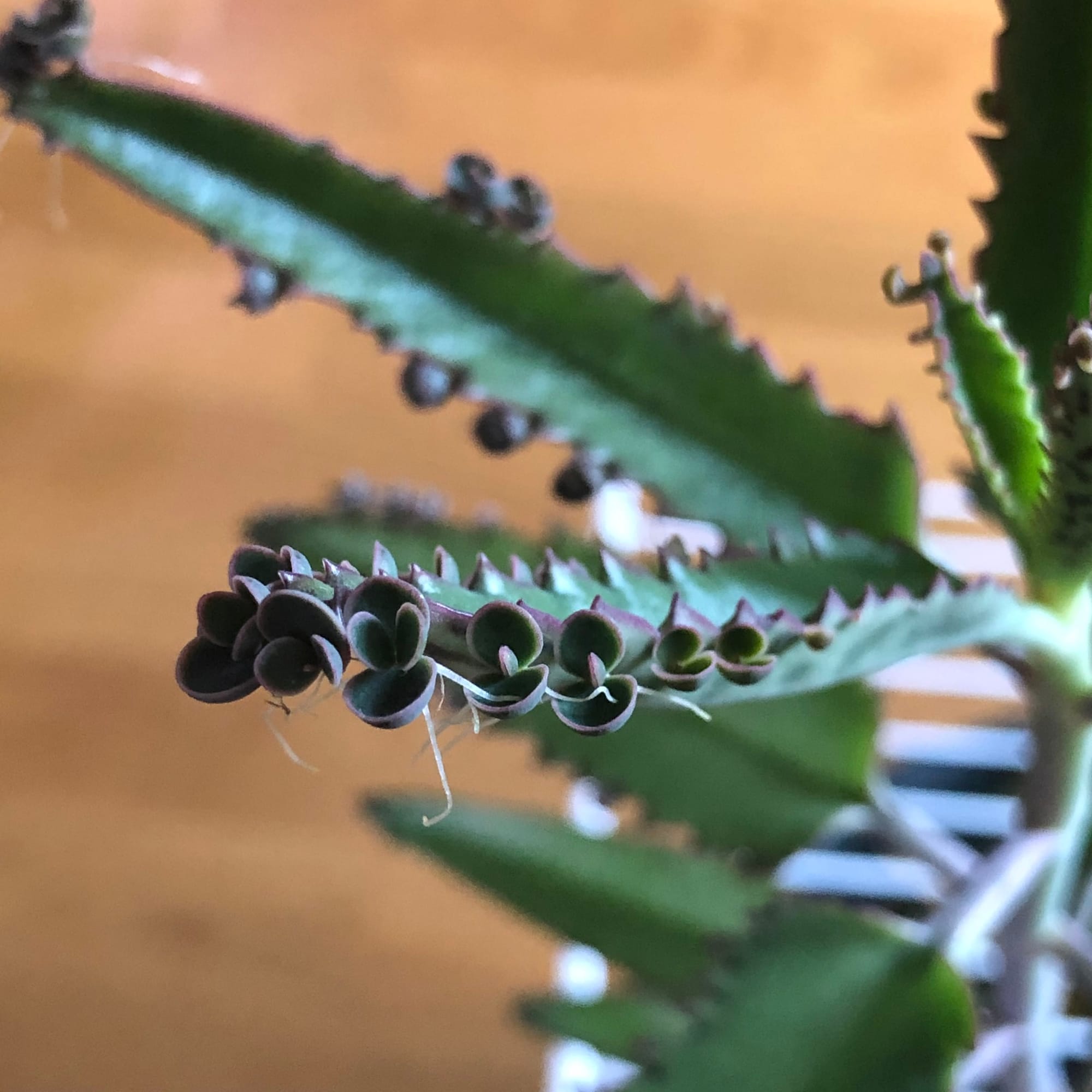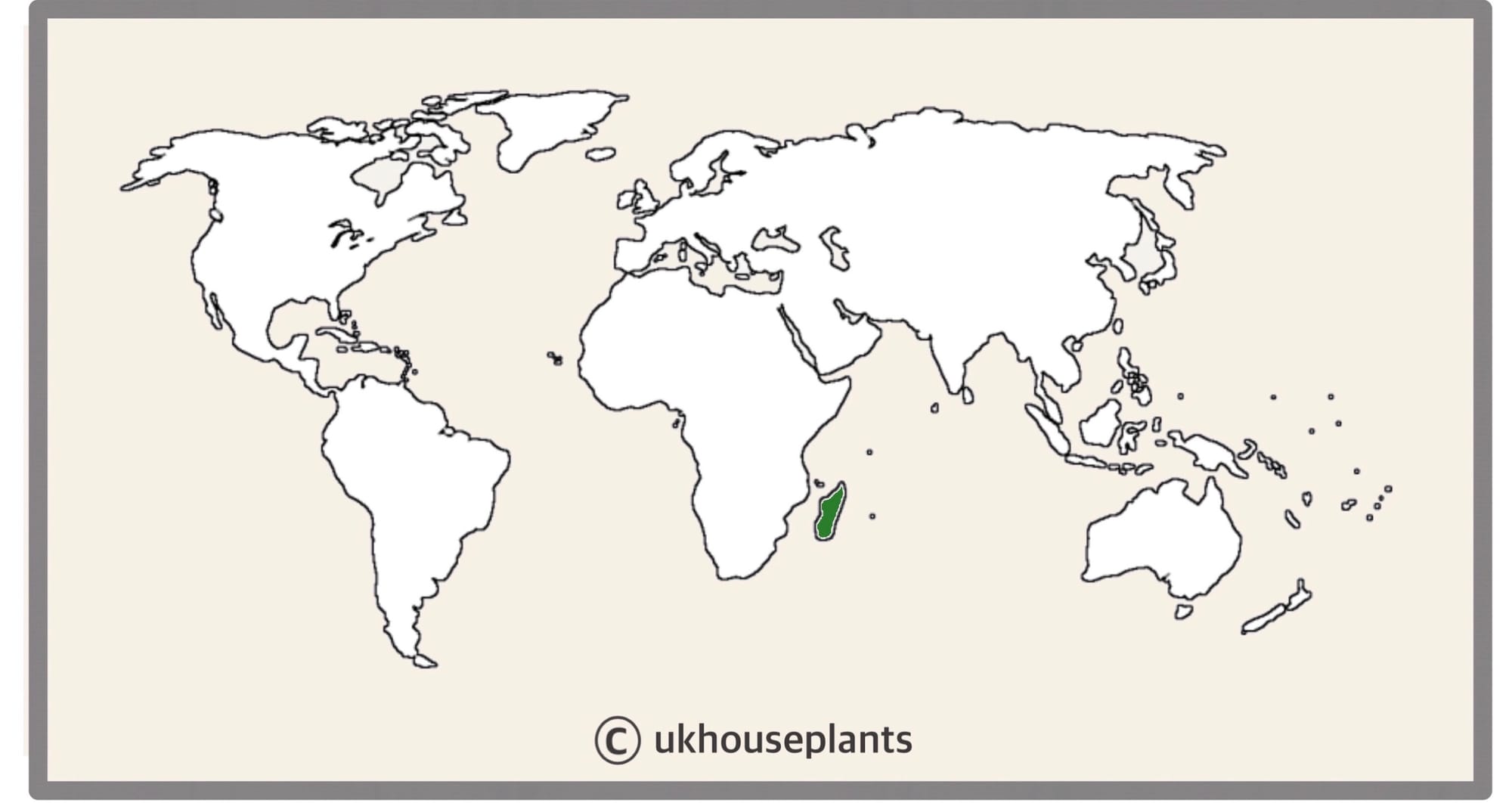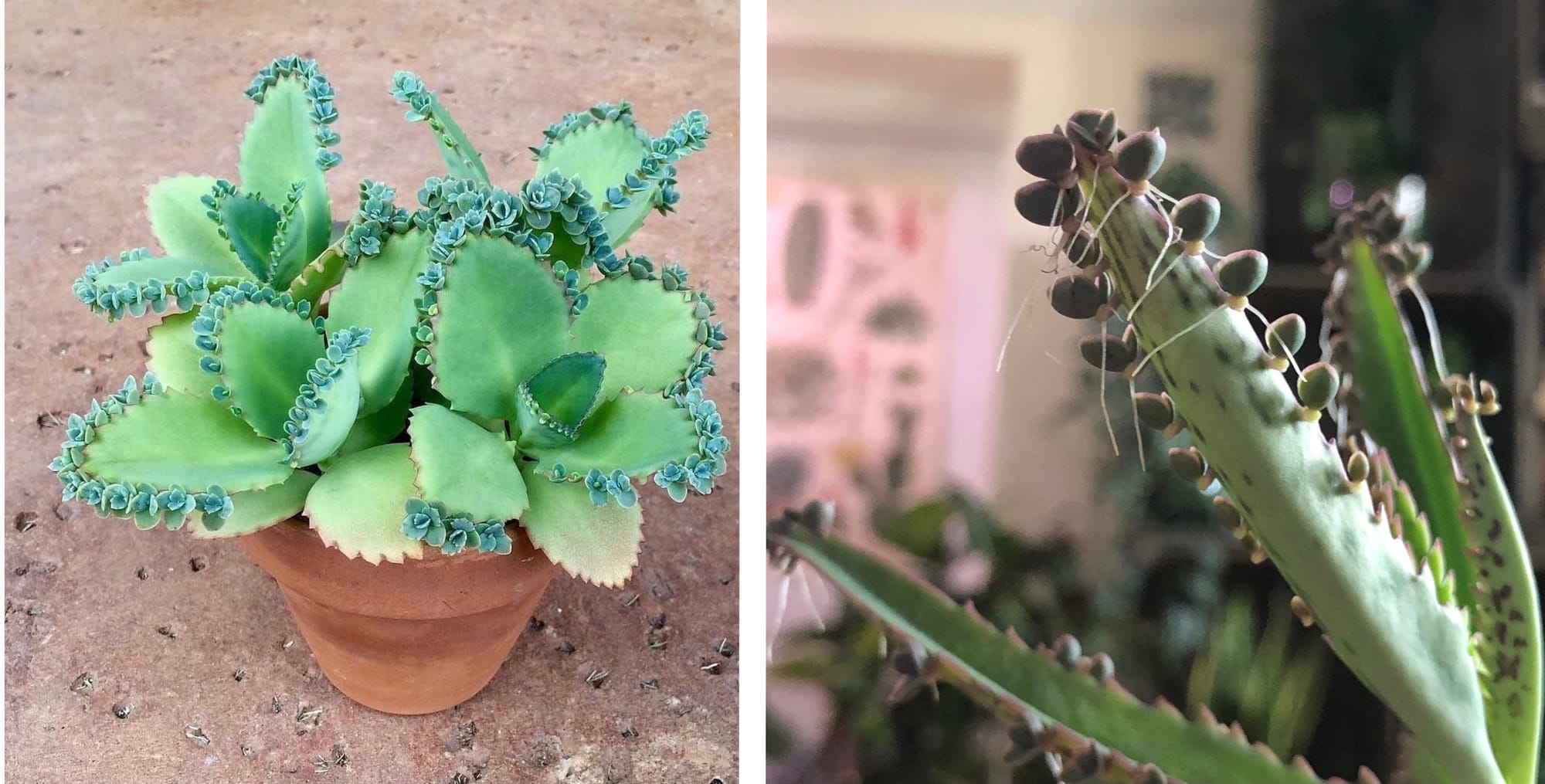
Kalanchoe × houghtonii. (Interspecific cultivar between Kalanchoe daigremontiana & K. delagoensis).
Contents
- Top Tips
- Location, Water, Humidity & Fertilisation
- Common Issues
- Origins, Temperature, Propagation, Repotting & Toxicity.
Need the answer to a specific plant query? Book a 1-to-1 video call with THE HOUSEPLANT DOCTOR™, the website's friendly author, to overcome and address your niggling problem! Available on iMessage, WhatsApp, Facebook Messenger & more.
Top Tips & Info
- Care Difficulty - Easy
- This article is tailored for both the Kalanchoe delagoensis & Kalanchoe × houghtonii, which is commonly sold under the name, 'Mother of Millions'.
- We'd recommend exposing yours to around two or three hours of sunlight per day for solid, reliable growth. Recently purchased specimens will need to build up their tolerance to the sun over the course of the next six weeks for avoiding sun-scorch.
- Under-watering is far better than over-doing it with this plant, so be sure to allow the soil's entirety to dry in between hydration.
- Fertilise every few months using a 'Cactus & Succulent' labelled feed.
- Repot every three to four years during the spring, using a 'Cactus & Succulent' labelled potting mix. It's best to keep your specimen pot-bound unless there are issues of root rot.
- Scroll down to 'Origins' to learn more about the difference between the 'Mother of Thousands' & 'Mother of Millions'.
- For information on propagating the small 'pups' that develop along the leaf-edges, scroll down to 'Propagation'.
Location & Light - 🔸🔸🔸
A bright, partial sun-filled location is perfect for good, healthy growth. We'd recommend a few hours of either morning or evening sunlight to replicate their natural habitat, as those kept in too shady locations will quickly show signs of leggy growth.
If you have recently bought yours, it can be trained to tolerate harsher levels of sunlight than most houseplants, by gently increasing the number of hours in the sun over the oncoming month. This process is best done from autumn to late winter, whilst the rays are at their weakest. Each week, increase the amount of light by an hour, starting with just an hour of morning sunlight to gain its momentum. The plant will slowly decease the production of chlorophyll, which in turn will reduce the risk of bleaching and sun-scorch. Remember to keep the specimen well hydrated during this period, and always abort the experiment if it shows signs of sun-scorch. The maximum amount of sunlight for this plant is around four hours a day.
Water - 🔸
To avoid plant-collapse via over-watering, allow the soil's entirety to dry out between waters thoroughly. The ukhouseplants saying of 'drenches between droughts' strongly applies to this species, so only rehydrate the soil when you feel it's necessary. Under-watering symptoms include a shrivelled stem, yellowing leaves, little to no growth and dry, crispy patches forming on the leaf edges. These issues are usually caused by too much light/heat or forgetfulness. Remember, the brighter the location, the more watering you'll need to do. Over-watering symptoms include a weakened or rotten stem, no new growth, yellowing lower leaves and eventual plant death. The differences between under and over-watering can be very similar, with a deflated root ball or basal collapse being the obvious difference.
Humidity -
This is not a necessity; however, a quick hose down from time to time will hydrate the leaves and wash away dust or potential pests.
Fertilisation - 🔸
Supplement once every few months using either a 'Cactus & Succulent' or a 'Houseplant' labelled fertiliser. As Mother of Millions naturally grow in nutrient-leached soils, forgetfulness of regular fertilisations won't be a serious detriment to their health. Never directly apply a 'ready-to-use' (RTU) without a pre-water first as this may lead to the burning or roots.
Common Issues with Mother of Millions
Root rot is a common issue with specimens sat in too moist or waterlogged soil for long periods. Symptoms include rapidly yellowing leaves, wilting, stunted growth and a rotten brown caudex. Take the plant out of the pot and inspect health below the soil line. If the roots sport a yellow tinge, you're good to go, but if they're brown and mushy, action must be taken immediately. More information about addressing root rot can be found on this link.
A tall, leggy Mother of Millions plant can be pruned by half to reduce its overall height and for stem cuttings. Scroll down to 'Propagation' to learn more about how to do this.
A dark location (shelves, corner-tables, etc.) will promote the specimen to develop small or no juvenile leaves, giving the impression of 'leggy' or naked growth. The length between the nodes will also dramatically become larger, harvesting less energy that can be converted into sortable sugars. Be sure to increase the amount of indirect light somewhat, and give the specimen a gentle supplement of 'Cactus & Succulent' labelled feed to help with its stored energy.
Curled leaves and dried brown edges are the result of too little water and over-exposure to the sun. Although they can naturally do well in sun-filled locations, those who haven't acclimatised to the harsh rays will show sun-scorch and environmental shock signs. Prolonged exposure will significantly speed the process of dehydration, so consider transplantation into a bigger pot in the spring to wrap the roots around moister soil.
Directly pinpointing yellow leaves is rather hard due to the many different issues that could be at fault. Problems include watering-related abuse, too much or too little light, and fertilisation issues. If you'd like to speak to ukhouseplants in regards to this issue, be sure to book a 1-to-1 video call for more detailed advice.
Mould or mushrooms developing on the soil means two things - too little light and over-watering. Despite the harmlessness, it'll prove unsightly to most gardeners and is therefore removed once known. To remove, replace the top two inches of the soil for a fresh batch of 'Cactus & Succulent' compost. Either increase the amount of light received (no direct sunlight for the first few weeks to prevent environmental shock) or decrease the frequency of waters slightly. If the mould is accompanied by yellowing lower leaves, you may also have a case of root rot.
Origins
This species was initially described in the early 1850s by Irish botanist, William Henry Harvey, who called it, Bryophyllum tubiflorum. This name would be accepted only for a few years, before Christian Ecklon and Carl Zeyher reclassified it in Kalanchoe - changing its specific epithet to 'delagoensis'.
Bryophyllum - Comes from Ancient Greek, translating to 'moss-covered' 'leaves' that possibly refers to the appearance of individual species. (Bryo & Phýllon).
Kalanchoe - Michel Adanson named the genus in 1763, honouring Czechian botanist, Georg Joseph Kamel (Camellus).
Delagoensis - Refers to the species' natural habitat of Delagoa, eastern Madagascar.
Houghtonii - Possibly in honour of American botanist, Arthur D. Houghton.
 The Distribution of Kalanchoe delagoensis.
The Distribution of Kalanchoe delagoensis.
What's the Difference between Mother of Thousands & Mother of Millions?
From a care requirement perspective, the difference between the two is minimal. Both species prefer to be kept on the drier side to life with partial exposure to the direct sun. The true difference stems from the shape of the leaves and a slight variance of their toxins. The 'Mother of Thousands' has wider, pinnate growth with the leaves developing in pairs, whereas the latter has thinner, pointed leaves and a darker tone - both are viviparous. An interspecific hybrid was created between the two species, named Kalanchoe × houghtonii, which has similar characteristics to the Mother of Millions (Right, image below). This species can be cared for using the information mentioned above.
 L: Mother of Thousands R: Mother of Millions
L: Mother of Thousands R: Mother of Millions
Temperature
12° - 32℃ (54° - 90℉)
H1a (Hardiness Zone 12) - Can be grown outdoors during the spring and summer in a sheltered location whilst nighttime temperatures are above 12℃ (54℉), but is fine to remain indoors, too. If you decide to bring this plant outdoors, don't allow it to endure more than three hours of direct sunlight a day as it may result in sun-scorch. Regularly keep an eye out for pests, especially when re-introducing it back indoors.
Spread
The overall size can be up to 1.5m (indoors) in height and 0.5 m in width, with the individual leaf reaching around 4cm. The ultimate height will take around fifteen years to achieve when repotted every few years.
Pruning & Maintenance
Remove yellow or dying leaves to encourage a better appearance and overall growing conditions. While pruning, always use clean scissors or shears to reduce the chance of bacterial and fungal diseases.
You can also prune the Mother of Millions' stem back by half when the plant has become too tall for your liking. The plant will produce a new branch just below the wound with fresh leaves (& pups). Scroll to the following section ('Propagation') to learn about how to root the pruned stem.
Propagation
Via Seed or Pups, Stem Cuttings.
Pups (Very Easy) - Pups that are located on mature leaves have the most potential due to its size and maturity. Gently place your fingers between the mother's leaf and the pups' base, pulling it sideways until you feel a subtle snap. Set the pups ON TOP OF a bed of moist 'Cactus & Succulent' compost for root growth. Not only will this callus the wound (to prevent disease), but it'll also speed up the propagation process considerably. Be sure to point them upwards, along with the absence of soil covering their foliage. The pups will naturally root into the soil within the following weeks, followed by rapid foliar growth soon after. Provide a bright setting with temperatures around 18°C (64°F) with the majority of the soil drying out in between waters. New leaves should emerge within a month or two, thus signalling the start of its independent life!
Stem Cuttings (Moderate) - Pruning the stem by half when the plant becomes too tall/leggy is a great time to take cuttings, too. Place the loose branch/cutting in a jar of water to root, which may take up to two months. It's important to submerge the bottom quarter of the stem's overall height to ensure enough stem is exposed to the water (for rooting). Once the roots are around 5cm (2in) in length, transplant it in a 10cm pot with 'Cactus & Succulent' labelled potting mix!
Flowers
Mother of Millions will rarely flower in a domestic setting due to the unfavourable growing conditions. For the sake of education, their flowers will appear only on mature specimens during the spring or summer months, with its flowers vaguely resembling orange trumpets.
Repotting
Repot every three to four years in the spring, using a 'Cactus & Succulent' labelled potting mix and the next sized pot with adequate drainage. Mother of Millions are far better potbound for several years due to the heightened risk of root rot and repotting-issues (like transplant shock) - so only repot if you feel it's wholly necessary.
Hydrate the plant 24hrs before tinkering with the roots to prevent the risk of transplant shock. For those situated in a darker location, introduce extra amounts of perlite and grit into the lower portion of the new soil to downplay over-watering risks. Click here for a detailed step-by-step guide on transplantation, or via this link to learn about repotting with root rot.
Pests & Diseases
Keep an eye out for mealybugs, scale, whitefly & root mealybugs. Common diseases associated with Mother of Millions are root rot, red leaf-spot, heart rot, botrytis & southern blight - click here to learn more about these issues.
Toxicity
This plant is classified as poisonous; if parts of the plants are eaten, vomiting, nausea, and appetite loss could occur. Consumption of large quantities must be dealt with quickly; acquire medical assistance for further information.
Retail Locations
Online Stores.
Book a 1-to-1 Call with THE HOUSEPLANT DOCTOR™
If you need further advice with your houseplants, book an advice call with ukhouseplants' friendly and expert writer today! This can be done via a video or audio call on most apps, including Facebook, FaceTime & Skype. A ten-minute call costs £5.99 (US$7), or £15.99 for thirty minutes. You can ask multiple questions, including queries on plants, pests, terrariums, repotting advice and anything in between. Please consider supporting this service to keep ukhouseplants thriving!